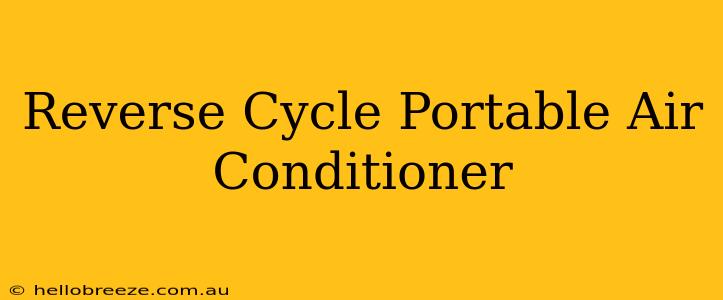Are you looking for a versatile and efficient way to regulate the temperature in your home? A reverse cycle portable air conditioner might be the perfect solution. These innovative units offer both heating and cooling capabilities, making them ideal for managing your indoor climate throughout the year. This comprehensive guide will explore everything you need to know about reverse cycle portable air conditioners, helping you make an informed decision for your comfort needs.
Understanding Reverse Cycle Technology
The term "reverse cycle" refers to the air conditioner's ability to switch between heating and cooling modes. Unlike traditional air conditioners that only cool, these units utilize a heat pump to transfer heat either out of or into your space. In cooling mode, they extract heat from the room and expel it outside. In heating mode, the process reverses, drawing heat from the outside air and releasing it into your home. This makes them incredibly energy-efficient compared to using separate heating and cooling systems.
Key Advantages of Reverse Cycle Portable Air Conditioners:
- Year-round climate control: Enjoy cool comfort in summer and cozy warmth in winter with a single unit.
- Energy efficiency: Reverse cycle technology often boasts significantly lower energy consumption than traditional systems.
- Portability: Easily move the unit from room to room as needed, offering flexibility for changing comfort requirements.
- Cost-effectiveness: While the initial investment might be slightly higher than a standard air conditioner, the long-term savings on energy bills can be substantial.
- Reduced carbon footprint: The improved energy efficiency contributes to a smaller environmental impact.
Choosing the Right Reverse Cycle Portable Air Conditioner
Selecting the ideal unit depends on several factors:
- Room size: The cooling and heating capacity (measured in BTUs or kW) should match the square footage of the space you intend to climate control. Underestimating capacity will lead to inefficient performance.
- Energy efficiency rating: Look for a high Energy Efficiency Ratio (EER) for cooling and Coefficient of Performance (COP) for heating. These ratings indicate how efficiently the unit converts energy into cooling or heating.
- Features: Consider features like programmable timers, remote controls, multiple fan speeds, and dehumidification capabilities to enhance convenience and comfort.
- Noise levels: Check the decibel rating to ensure the unit won't be overly disruptive.
- Installation: While portable, some units require venting to the outside, so assess your window or wall space accordingly.
Installation and Maintenance
Most portable reverse cycle air conditioners are relatively easy to install, typically involving attaching an exhaust hose to a window or wall. However, proper ventilation is crucial for optimal performance and safety. Refer to the manufacturer's instructions for detailed installation guidance. Regular maintenance, including cleaning the filters and coils, is essential for maximizing efficiency and longevity.
Are Reverse Cycle Portable Air Conditioners Right for You?
Reverse cycle portable air conditioners are a smart choice for anyone seeking efficient and versatile climate control. They offer significant advantages in terms of energy savings, convenience, and environmental friendliness. If you're looking to upgrade your home comfort system or need a flexible solution for smaller spaces, investing in a reverse cycle portable air conditioner is a decision you'll likely appreciate year after year. However, for larger homes or extreme climate conditions, a more permanent, central heating and cooling system might be a better fit. Carefully consider your specific needs and budget before making a purchase.

